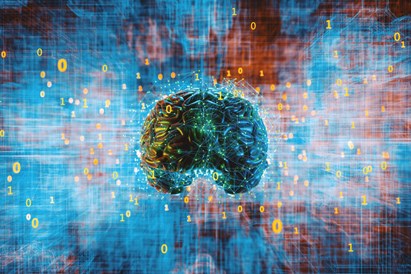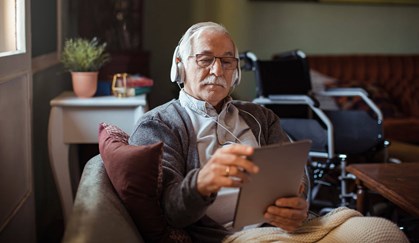Jessica Monaghan and David Allen discuss how machine learning, using a wealth of data provided by hearing devices, can be used to streamline their functionality and fitting. They report on how it has been used to support clinicians to maximise the effectiveness of patient appointments, and how it could help to rationalise patient care pathways and provide a diagnostic tool for rapid detection of problems.
The world is awash with data, much of it informative to an individual’s health and wellbeing. Whilst extracting information from these data can increase the sophistication with which practitioners can target healthcare towards individualised treatment, the sheer volume of data generated can be daunting.
In addition, the ubiquity and volume of information available raises significant concerns for how personal data are harvested and used. Even when these fears are allayed, putting data to good use - for our own benefit - will require a transformation in how health data are analysed, and by whom. Fortunately, automatic approaches to analysing ‘big data’, diagnosing illness, recommending treatments, and even generating scientific hypotheses for future testing, are now possible through automated advanced statistical processes involving ‘machine learning’. Simply put, machine learning is an approach to analysis in which computers learn patterns present in data rather than being programmed with specific rules. These learned patterns, or ‘trained models’, can then be used to make predictions when provided with new data.

Machine learning has the potential to transform the practice of audiology.
In an ageing population with increasing need for hearing healthcare, an audiologist’s time will be in increasing demand. Machine-learning techniques have the potential to increase the accuracy and efficiency of diagnosis, identify those with hearing problems before they reach the clinic, and monitor changes to listening behaviour that may indicate problems with hearing devices or changes in hearing function. Machine learning underpins assistive technology, such as automatic transcription software, that can be very beneficial in audiology clinics (www.nal.gov.au/nalscribe). Clinical data can also be used to predict which individuals might benefit from interventions, or the interventions that might prove of most benefit. By enhancing the efficiency of routine clinical tasks, machine learning can allow audiologists more face-to-face time in appointments for more uniquely human activities, such as discussing hearing goals and counselling clients.
“Computer vision techniques can help identify middle ear disease from otoscopy images, enabling remote communities without ENTs to diagnose and treat conditions without delay”
Machine-learning approaches largely fall into two categories: offline, in which data are collected and provided to an algorithm for conversion into a single trained model that can then be deployed into the field, and online, in which the model is continually updated as new data become available. As model training and updating requires significant computing power, historically offline learning approaches have more frequently been employed. One prominent example is the NAL-NL2 hearing aid gain prescription which, in part, makes use of a trained model that has been deployed many millions of times. In contrast to the large amount of computing power, data, and expertise required to generate this model, new predictions can be generated on small embedded devices, including hearing aids and even consumer headphones.
Offline machine learning is already being used to facilitate remote delivery of hearing care. Although air conduction thresholds can be measured remotely with reasonable accuracy, the data do not immediately identify, for example, middle ear-pathologies that may require further investigation. Computer vision techniques can help identify middle ear diseases from otoscopy images, enabling remote communities without ENT practitioners to diagnose and treat conditions without delay [1]. At the National Acoustic Laboratories (NAL), we are using a dataset of audiograms from more than 800,000 clients to train a machine-learning model to predict the presence of an ‘air-bone gap’, i.e. the difference between air-conduction and bone-conduction thresholds, to identify possible middle-ear problems, with accuracy up to 86% [2], and we believe we can enhance this by incorporating data from questionnaires.
We are also investigating the use of machine learning to identify children with hearing loss by analysing their speech [3], a potentially powerful screening or monitoring tool for parents and carers or an alternative to behavioural testing in the clinic - often challenging for children under three years of age. Applying this approach to speech data from the Longitudinal Outcomes of Children with Hearing Impairment (LOCHI) study, we trained a machine-learning model to identify whether a previously ‘unheard’ sample of speech was from a child with hearing loss or with normal hearing, achieving an accuracy of 96%. We aim to collect speech data from more children to increase the model’s generalisability and develop a useful screening tool.
“Large-scale longitudinal health studies demonstrate that an individual’s risk of hearing loss can be predicted from other health information, such as the presence of diabetes or heart disease, and vice-versa”
In contrast to offline learning, online learning approaches require significant computing power for prediction and model updating. With ubiquitous internet connectivity, this is often provided by transmitting data to a centralised location to be processed. As hearing devices become increasingly connected to smartphones and the internet, data about users’ listening environments and patterns of use, provide a rich source of information - indeed these types of data have already been used as input to machine-learning algorithms. Automated processing of these data can alert clinicians to emerging issues with devices, automatically update noise-reduction algorithms, and provide new insights into the ways in which people with hearing difficulty navigate their environments. Online techniques have the potential to enhance the effectiveness and efficiency of diagnosis, with algorithmic control of pure-tone audiometry and electroacoustic testing resulting in faster, and more precise, assessments of hearing sensitivity.
Machine-learning techniques scale well to extremely large data sets, allowing for the extraction of useful information from a wide variety of data, even where the relevant informational content is low. Large-scale longitudinal health studies demonstrate that an individual’s risk of hearing loss can be predicted from other health information, such as the presence of diabetes or heart disease, and vice versa [4]. Hearing devices are also increasingly combined with accelerometers and other sensors that may identify stroke, deteriorations in motor function, or neuropathies. The challenge in all of this is whether the available data provide sufficient information to provide useful predictions.

Machine-learning enhanced technology can increase the
accuracy and efficiency of tele-audiology assessments.
Whether offline or online, however, the most significant factor in the success of machine-learning approaches is the quality and quantity of data used to train the model. Importantly then, the future power of machine learning relies on ensuring that the data collected in audiology and ENT clinics are processed and stored in a standardised way. Machine learning has the potential to use readily available data in new ways, enhancing the effectiveness and the efficiency of hearing care. However, as with any new technology, care is required to ensure that practitioners use evidence-based methods that provide the best possible experience and outcome to their patients.
References
1. Myburgh HC, Van Zijl WH, Swanepoel D, et al. Otitis media diagnosis for developing countries using tympanic membrane image-analysis. EBioMedicine 2016;5:156-60.
2. Allen D, Monaghan JJM. Use of air conduction thresholds to predict bone conduction asymmetry and air-bone gap. First Virtual Conference on Computational Audiology 2020.
https://computationalaudiology.com/
use-of-air-conduction-thresholds-to-
predict-bone-conduction-asymmetry
-and-air-bone-gap/
3. Monaghan JJM , Allen D. Detecting hearing loss from children’s speech using machine learning. Second Virtual Conference on Computational Audiology 2021;
https://computationalaudiology.com/
detecting-hearing-loss-from-childrens
-speech-using-machine-learning/
4. Kim M, Zhang Y, Chang Y, et al. Diabetes mellitus and the incidence of hearing loss: a cohort study. International Journal of Epidemiology 2017;46(2):717-26.
All links last accessed November 2021.
Declaration of Competing Interests: The authors are employed by the National Acoustics Laboratory which developed and licences NAL-NL2.







